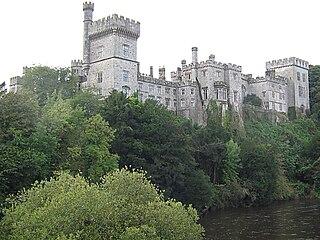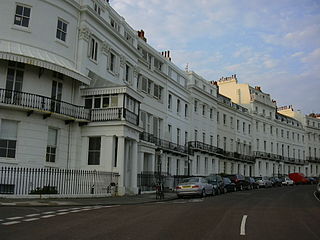This page is based on this
Wikipedia article Text is available under the
CC BY-SA 4.0 license; additional terms may apply.
Images, videos and audio are available under their respective licenses.

Lismore Castle is the Irish home of the Duke of Devonshire. Located in the town of Lismore in County Waterford in Ireland, it belonged to the Earls of Desmond, and subsequently to the Cavendish family from 1753. It was largely re-built in the Gothic style during the mid-nineteenth century by William Cavendish, 6th Duke of Devonshire.
The Worshipful Company of Mercers is the premier Livery Company of the City of London and ranks first in the order of precedence of the Companies. It is the first of the Great Twelve City Livery Companies. Although of even older origin, the Company was incorporated under a Royal Charter in 1394, the Company's earliest extant Charter. The Company's aim was to act as a trade association for general merchants, and especially for exporters of wool and importers of velvet, silk and other luxurious fabrics (mercers). By the 16th century many members of the Company had lost any connection with the original trade. Today, the Company exists primarily as a charitable institution, supporting a variety of causes. The Company's motto is Honor Deo, Latin for "Honour to God".

Regency architecture encompasses classical buildings built in the United Kingdom during the Regency era in the early 19th century when George IV was Prince Regent, and also to earlier and later buildings following the same style. The period coincides with the Biedermeier style in the German-speaking lands, Federal style in the United States and the French Empire style. Regency style is also applied to interior design and decorative arts of the period, typified by elegant furniture and vertically striped wallpaper, and to styles of clothing; for men, as typified by the dandy Beau Brummell, for women the Empire silhouette.

Interior design is the art and science of enhancing the interior of a building to achieve a healthier and more aesthetically pleasing environment for the people using the space. An interior designer is someone who plans, researches, coordinates, and manages such projects. Interior design is a multifaceted profession that includes conceptual development, space planning, site inspections, programming, research, communicating with the stakeholders of a project, construction management, and execution of the design.

Automotive design is the process of developing the appearance, and to some extent the ergonomics, of motor vehicles, including automobiles, motorcycles, trucks, buses, coaches, and vans.

Thomas Hosmer Shepherd (1792–1864) was a topographical watercolour artist well known for his architectural paintings.
1813 in Australia featured a number of important developments. Gregory Blaxland, William Lawson and William Charles Wentworth crossed the Blue Mountains which opened up the interior of New South Wales for European settlement. John and Elizabeth Macarthur sent the first wool exports from their properties.
Edward Kendall Crace (1844–1892) was an Australian pastoralist who owned extensive land holdings around Canberra.

This armoire, displayed at the Great Exhibition of 1851, was designed by Augustus Welby Northmore Pugin (1812–52) and made by frequent collaborator John Gregory Crace (1809–89). The shields along the top and the carved decorative motifs were drawn from medieval sources. The motifs include Crace's initials, a plummet as an emblem of his honesty, and a compass to indicate his ability to keep within his estimates. Many designers of the Victorian period were inspired by the art of the Middle Ages, but Pugin was probably the greatest and most ardent exponent of the Gothic Revival style.

Fife House, No 1, Lewes Crescent, is a Grade I listed building in Kemp Town, Brighton, United Kingdom, which was previously owned by the Duke of Devonshire and the Duke of Fife; it is not to be confused with the former Fife House, Whitehall, in London.

James Crace is an English writer and novelist. His novels include Quarantine, which was judged Whitbread Novel of 1998, and Harvest, which won the 2015 International IMPAC Dublin Literary Award, the 2013 James Tait Black Memorial Prize, and was shortlisted for the 2013 Man Booker Prize.
Lauren Rose Crace is an English actress and radio presenter, known for her portrayal of Danielle Jones in the BBC soap opera EastEnders from 2008 to 2009.

Frederick Crace (1779–1859) was an English interior decorator, who worked for George IV when Prince of Wales, for whom he created the chinoiserie interiors of the Brighton Pavilion. Crace was also a collector of maps and topographical prints, now at the British Library.
Gregory Phillips Architects', founded in 1991, is a London Based Architecture and Interior Design studio, known primarily for their work in the high end residential market.










